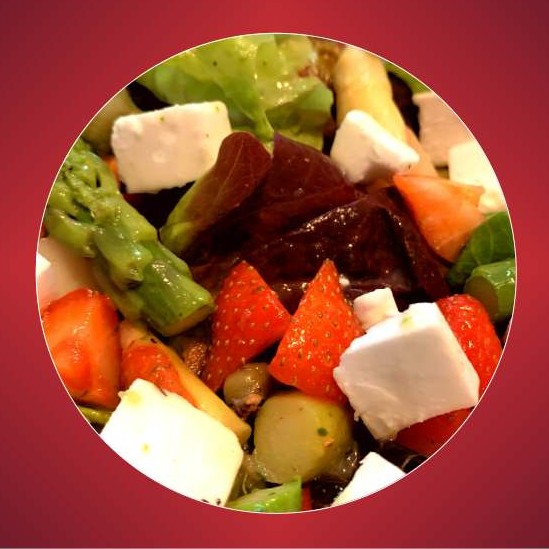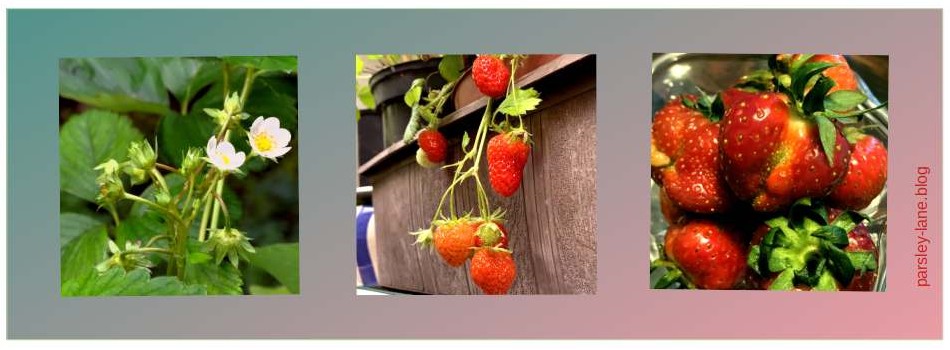Straw Bedded
These delicate fruits have extravagant housing preferences. Like straw bedding. Or a good view of the city (Ingredient Special on Strawberries plus recipe ‘Exclamation Marks’, Rcp# 43)
One of the most wondrous places was my grandparents’ garden. They knew a lot about growing food and loved tending to their little patch of delicious paradise. What they did not turn into meals, pies, jams, or preserves in old-fashioned jars, they swapped with their neighbors. Which was pretty normal in their day.
During one of the many summer vacations I spent there, I noticed something strange. My grandfather had covered an entire garden bed with straw in mid spring. Only a few meager, dark green plants were sticking out.
“Why are you putting the straw under these plants?” I wondered.
My grandmother put on that knowing ‘Oh, those young and ignorant city folk’ face and smiled: “Because these are strawberries. They hate to get their feet wet and their leave coats soaked. So we cover the ground to keep the plant dry from underneath and it won’t get sick.” Which I thought made perfect sense. And that’s how I learned about the straw and the berries that grow on it.
In German, strawberries are called ‘Erdbeeren’ (ground berries), which refers to the same challenge – they grow close to the ground. And they love moisture at their disposal, but the leaves can’t take too much of it or they get a big mildew problem.
Of course, there are other ways to deal with issue. For example, plant the berries not on the ground, but in hanging containers or in ‘strawberry urns’. Also, as I just learned from a very good book (see the TableTalk with the expert on mixed cultivation, Ortrud Grieb in the post [‘Best Beeties, Best Buddies’]), you can relieve the stress by planting garlic or chives next to the strawberries, because these will fight the organism that starts the mildew. So now I grow them next to garlic chives (looks like regular chives but tastes like garlic).
I don’t need to tell you about the taste of the fruit, because it’s legendary. So it’s no wonder that animals love the berries, too. Someone just told me that she plants annual or wild strawberries near the perennial larger cultivated ones. They usually grow a lot of fruit that is sweeter, so the animals will prefer that. Especially birds will fall for this trick. But when the berries are ripe, the ants will still feast on them. To repel them, try a very strong tea of fresh ginger. Let it sit for about two days. It’s just right when it starts to stink a little and foam up. Then spray it on the plants, but only lightly from below and not during very hot periods. You can also pour the liquid around the plant. Both will do the trick against aphids and other leaf suckers as well.
Of course, news of delicious treats travels just as fast in the general animal kingdom as it does among us humans, so wild animals have taken to strawberries. For example, some people in my family have a small flock of dears that occasionally wander into their backyard. There is plenty of food, but you know the phenomenon: The grass is always greener on the other side of the fence. Well, when they leave, the raspberries are missing their tops and the strawberries usually have a military haircut. Which, in this case, rightly suggests that the green part of the berries is edible (smaller ones without stems, see [‘A Matter of Edibility’]). I even use the dried leaves to season soups.
And there are clear nutritional benefits: Since I don’t eat meat, I have to watch my iron intake. Strawberries are on the positive list because they contain a good amount of it. Which means, of course, that the plant must be getting it from somewhere. So, if your strawberries look a little pale around the leaves – just like people who do not get enough iron – they may need iron. If you are not sure, take a picture and go to the nursery of your choice and ask for help.
Back to cooking, of course, there are always the familiar uses: Strawberry cake is one of my favorites, and they are spectacular on a bowl of vanilla and chocolate ice cream (try dairy-free alternatives, they tend to be much lighter than those made with cream). But as we know from a classic, they are also really good with salad (see recipe ‘Exclamation Marks’ below).
When I was thinking of a title for this post, I remembered a fairy tale I loved as a child. In it, a wise queen advises her son to find his future bride by having her sleep with a single dried pea under her mattress. Because only true royalty will know the difference, she said. Well, of course, the story had a happy ending and the prince found his true love. That’s probably why the strawberries wear their royal red silk robes with little jewels on them. Because the right bedding will tell you the truth – about love and berries.
Side Notes
- As usual, you will find a recipe to go with this ingredient special below. Proving my point that the best bedding for ripe strawberries is indeed dark green, not light yellow, and made of salad leaves.

Exclamation Marks
That’s what you get from combining asparagus with strawberries: A nice salad (With Ingredient Special on Strawberries, Rcp# 43)
Ingredients of ‘Exclamation Marks’
- 250 – 300g fresh strawberries
- 500 – 600 g white asparagus (leftover asparagus broken at harvesting is perfect)
- 150 – 200 g green asparagus
- 40 g capers (jar with capers preserved in water)
- 150 g mild feta cheese (plant-based)
- 150 ml olive water (from a jar of green or dark olives, marinated with vinegar and salt) or self-made broth [‘Vegetable Broth’]
- 3 tablespoons crushed and crumbled cashew ‘nuts’ (seeds)
- 1 tablespoon raw cane sugar
- 3 tablespoons mild olive oil
- 12 tablespoons oat yogurt
- Canola oil for browning
- Freshly ground nutmeg
- 1 teaspoon bear’s garlic in oil
- 250 – 300 g of washed green salads and leaves (3 – 4 large portions to fill a salad bowl for each person, such as a mix of arugula, young spinach, dark oak leaf salad, lamb’s lettuce)
Preparations for ‘Exclamation Marks’
- Wash the asparagus. Peel and cut off the tough ends. Keep the scraps and put them in a saucepan with a tablespoon of sugar and 1 liter of boiling water. Bring to the boil, then lower the temperature and simmer for 15 minutes over a medium heat.
- In the meantime, cut off the tips of the white and green asparagus. Turn the heat to low, remove the cooked vegetable scraps with a slotted spoon, and add the green asparagus tips to the barely simmering water. After 5 minutes, add the white asparagus tips. Simmer together for 5 to 8 minutes. They should be cooked but still a little crunchy. Turn off the heat, remove the asparagus tips from the pot and place them on a plate to cool. Allow the stock to cool to lukewarm.
- Wash the strawberries carefully but thoroughly and cut off the top generously, leaving the green on. It’s best to cut off the round tops, leaving only the conical bottom of each fruit. Set the rest of the strawberries aside and refrigerate.
- Cut both the white and green peeled asparagus into pieces about 4 – 5 cm long. Heat a medium sized non-stick skillet with 2 – 3 tablespoons of canola oil. Saute the asparagus pieces over a low heat for about 10-15 minutes, until they are tender but still have a little bite. Remove from the pan and set aside on a large plate to cool to lukewarm.
- Place the strawberry tops, with the green down, in the warm pan. Gently brown the green and tops over low heat (with an additional tablespoon of canola oil if needed) for 5 minutes, but do not turn. Remove the strawberry tops from the pan and cool on a plate (with the green downside) to lukewarm.
- Return the pan to medium heat and add two more tablespoons of canola oil. Toast the crushed cashews. Be careful, they burn easily.
- Turn off the heat and pour the olive water or broth into the pan (be careful, any temperature difference may cause spattering) and gently remove the frying residue. Pour the liquid with the toasted cashews into a heat-resistant bowl. Add the olive oil, bear’s garlic, ground nutmeg, capers and 100 ml of the cooled asparagus stock. Stir well, then set aside in a cool place to cool to lukewarm.
- Add the cooled asparagus pieces (not the tips) to the mixture and marinate for 10-15 minutes. Carefully toss in the fried strawberry tops with greens and marinate for another 5-10 minutes in a cool place.
- Wash and coarsely chop or tear the lettuce. Place each serving of lettuce in an individual serving bowl.
- Remove the solids from the marinade and gently combine with the chopped leaves in the salad bowls. Add the oat yogurt to the cooled marinade and stir well, then pour half of the sauce over the lettuce mixture in the bowls.
- Add the blanched and cooled asparagus tips and the raw cooled strawberry bottoms – halved – to the salad.
- Pour the remaining salad dressing over the salad. Finally, place the feta cheese on top of the salad.
Makes 3- 4 servings.
Side Notes:
- We recently confirmed how well strawberries go with salad when we made a leftover salad before going on vacation. So mix and match whatever you have in the fridge and you’ll be amazed at the new combinations you’ll discover. And if it doesn’t work out, try a variation next time. Sometimes I try five different versions of the same recipe before I find the final one.
- When I created this recipe, the idea of combining strawberries with asparagus came first. At the time, our local seasonal calendar clearly indicated that such a combination would be a perfect match, and the ingredients were readily available here. But then April and May were so warm this year that the asparagus season ended well before the end of June. I just made the salad yesterday – I always make and check my recipes several times. But this time I relied on pre-cooked white asparagus. Local green asparagus was available, but only because our favorite organic grocery store has a “very hot line” to the local farmers. So this salad is probably more of a May salad for next year. Anyway, it was an interesting experience for me to see how much local temperature fluctuations can change traditional harvest patterns and the usual availability of local foods.

Please note: For all my recipes (text) on this blog (By MagS, Parsley-Lane Blog) I grant a CC license under the terms of BY-NC-SA 4.0 (Attribution-NonCommercial-ShareAlike). For further explanations, please see the Legal Notice or visit creativecommons.org.
